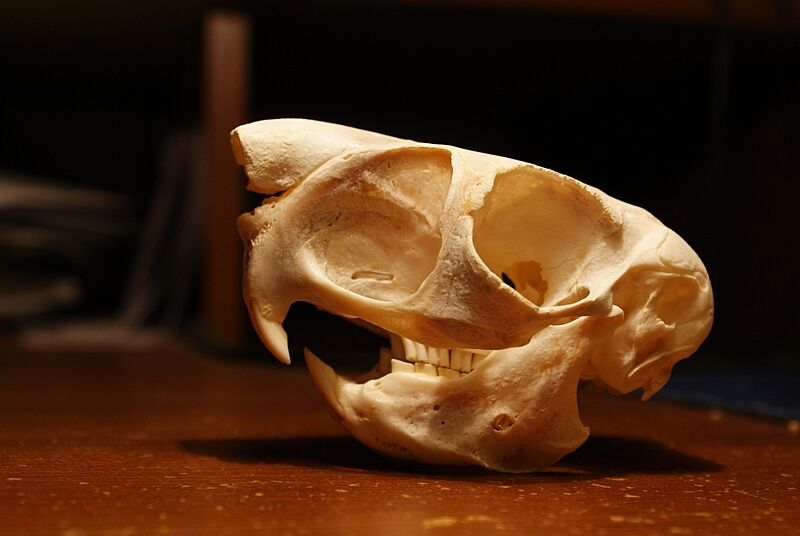Image: Pedetes-capensis-skull

Description: Pedetes capensis skull, South Africa. Despite their name, the springhare, or the springhaas, is not a hare or lagomorph, but an anomaluromorph rodent in the family Petetidae. Although springhares are highly hystricomorphous, with a greatly englarged infraorbital foramen (large hole anterior to the orbit above, which serves as an attatchment site for the medial masseter muscle), they are more closely related to the strange scaly-tailed squirrels (Anomaluridae) than to Hysticomorpha (which includes the porcupines, capybaras, guinea pigs, chinchillas, among many others). Springhares are highly convergent to rabbits and hares, both superficially with their saltatorial locomotion (jumping behavior), large hind feet, and elongated ears, but also in some of the fine details of the skull, such as a highly reduced temporalis muscle with a small to nonexistent coronoid process on the mandible (blocked by the zygomatic arch here, but you can tell it doesn't extend upward very high, and notice how small the area is for insertion of the temporalis on the skull compared with most mammals). Massively enlarged auditory bullae (the inflated bones in the back of the skull that house the ear bones) are indicators of the jumping lifestyle, and are seen in other rodent jumpers such as jerboas (Dipodidae), kangaroo rats (Heteromyidae), and the vischachas and chinchillas (Chinchillidae). Despite the fact that I cited one of the similarities between true hares and springhares as jumping, the type of saltatorial locomotion they practice is distinctly different. Springhares jump like the previous groups of rodents I mentioned (jerboas, kangaroo rats) and macropods (true kangaroos), in that they hop bipedally consecutively before allowing their forelimbs to touch the ground again, and usually can remain in a bipedal position indefinitely, and are not obligated to stand quadrupedally, like hares and rabbits are (although I'm sure a hare or rabbit could manage stand up right for a while, but then again, so could my pet dashund). Hares and rabbits are more like anurans (frogs, toads, etc.), in that they can jump well, but must land on all fours before jumping again (Pumas are the cat analog of this behavior, in a sense, as they're hind legs are more proportionately longer than their forelegs than any other cat, and they leap rather well). To see their living cuteness (and they are very very cute), see: animaldiversity.ummz.umich.edu/site/resources/lazette_gif... Or to see some beautiful CT cut-aways of one of these skulls, see: www.digimorph.org/specimens/Pedetes_capensis/
Title: Pedetes-capensis-skull
Credit: Springhare (Pedetes capensis)
Author: Dallas Krentzel
Usage Terms: Creative Commons Attribution 2.0
License: CC BY 2.0
License Link: https://creativecommons.org/licenses/by/2.0
Attribution Required?: Yes
Image usage
The following page links to this image:

